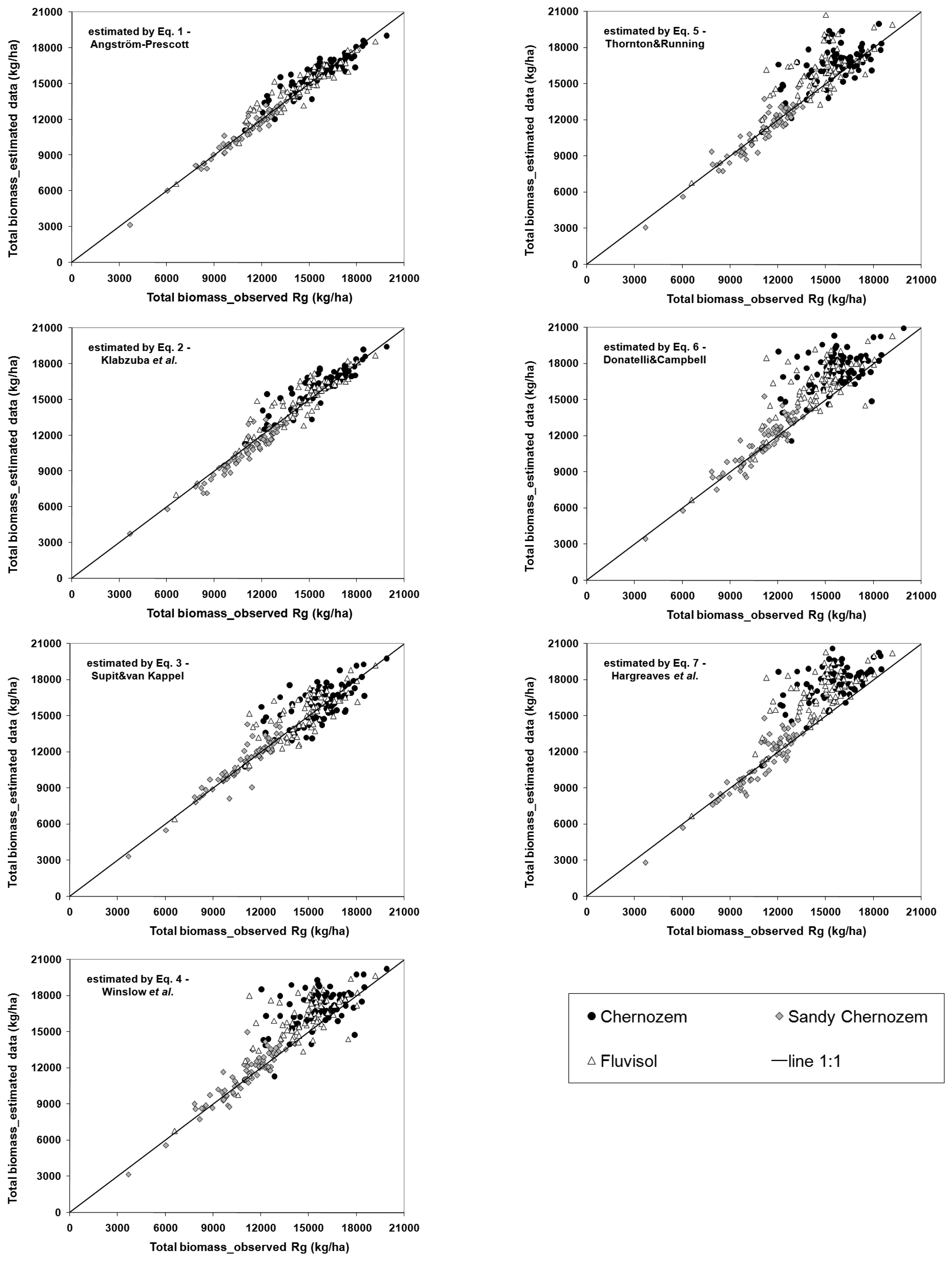Effect of Estimated Daily Global Solar Radiation Data on the Results of Crop Growth Models
Abstract
:1. Introduction
2. Material and Methods
2.1. Definition of the Study Area
2.2. Methods of Estimating Daily RG Values
2.3. Crop Models
2.4. Setting up the CERES Models for Site Specific Simulation Runs
2.5. Setting up the WOFOST Model for Spatialised Simulation Runs
2.6. Evaluation of the Model Outputs
3. Results
3.1. Site Specific Analysis: Spring Barley
3.2. Site Specific Analysis: Winter Wheat
3.3. Spatial Analysis: Winter Wheat
4. Discussion
5. Conclusions
Acknowledgments
Appendix
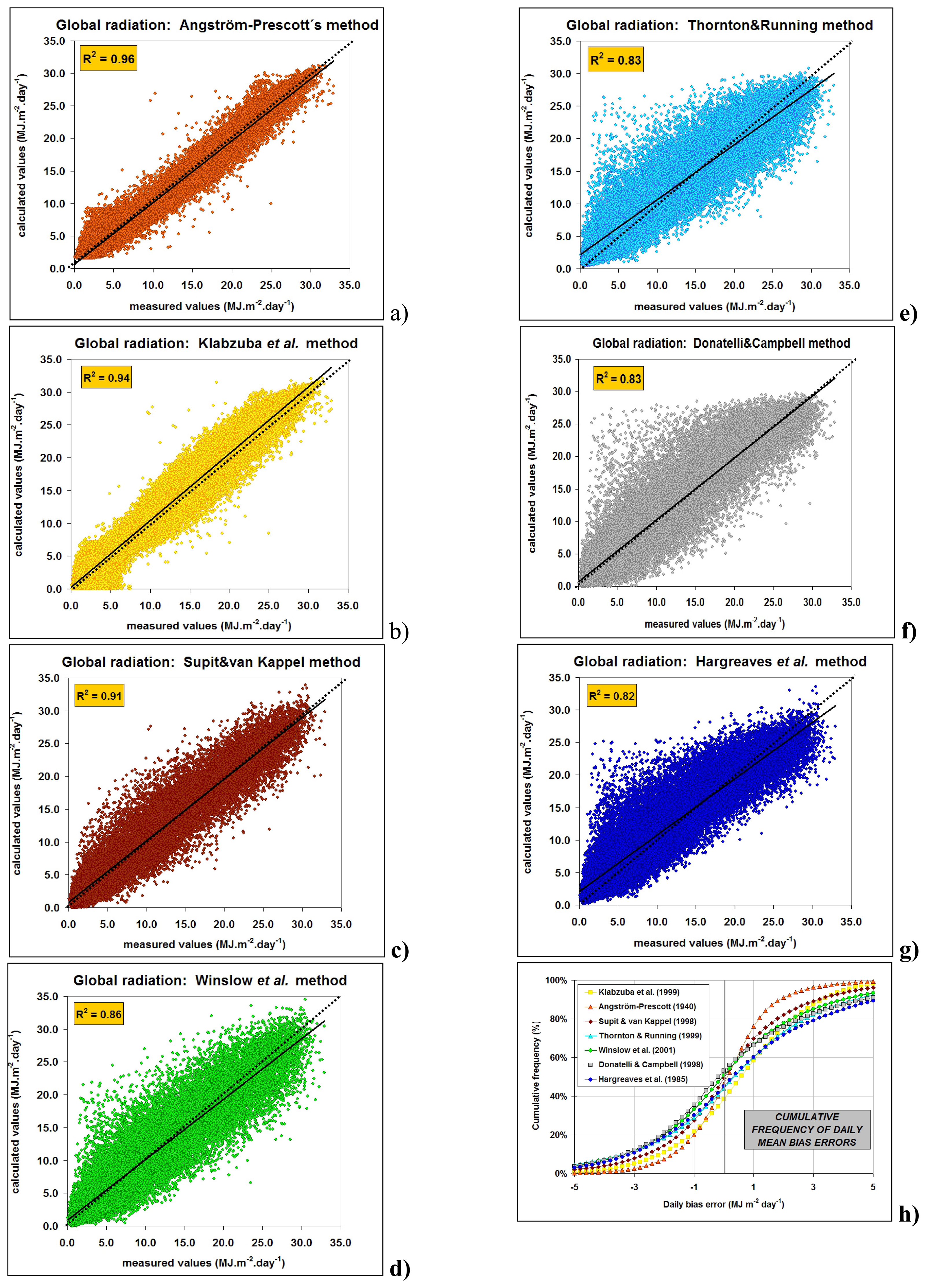
References and Notes
- Wit de, C.T.; Penning de Vries, F.W.T. Predictive models in agricultural production. Phil. Trans. R. Soc. London B 2005, 310, 309–315. [Google Scholar]
- Aggarwal, P.K. Application of systems simulation for understanding and increasing yield potential of wheat and rice. Ph.D. Thesis, Wageningen Agriculture University, 2000; p. 176. [Google Scholar]
- Diepen van, C.A. An Agrometeorological model to monitor the crop state on a regional scale in the European Community: Concept implementation and first operational outputs. Proceedings of the Conference on Application of Remote Sensing to Agricultural Statistics, Belgirate, Italy; 1992; pp. 269–277. [Google Scholar]
- Perdigão, V.; Suppit, I. (Eds.) An Early Crop Yield Estimation Method for Finnish Conditions: The crop growth monitoring system of the Joint Research Centre with and without Remotely Sensed and other Additional Input data; EUR-18975 EN 1999; p. 144.
- Wolf, J.; Evans, L.G.; Semenov, M.A.; Eckersten, H.; Iglesias, A. Comparison of wheat simulation models under climate change I Model calibration and sensitivity analyses. Climate Research 1996, 7, 253–270. [Google Scholar]
- Alexandrov, A.; Hoogenboom, G. The impact of climate variability and change on crop yield in Bulgaria. Agric. For. Meteorol 2000, 104, 315–327. [Google Scholar]
- Izaurralde, R.C.; Rosenberg, N.J.; Brown, R.A.; Thomson, A.M. Integrated assessment of Hadley Center (HadCM2) climate change impacts on agricultural productivity and irrigation water supply in the conterminous United States Part II Regional agricultural production in 2030 and 2095. Agric. For. Meteorol 2003, 117, 97–122. [Google Scholar]
- Landau, S.; Mitchell, R.A.C.; Barnett, V.; Colls, J.J.; Payne, C.J. A parsimonious multiple-regression model of wheat yield response to environment. Agric. For. Meteorol 2000, 101, 151–166. [Google Scholar]
- Han, D.; O'Kiely, P.; Sun, D.W. Application of Water-stress Models to estimate the Herbage Dry Matter Yield of Permanent Grassland Pasture Sward Regrowth. Biosystem Engineering 2003, 84, 101–111. [Google Scholar]
- Supit, I.; van Kappel, R.R. A simple method to estimate global radiation. Solar Energy 1998, 63, 147–160. [Google Scholar]
- Liu, D.L.; Scott, B.J. Estimation of solar radiation in Australia from rainfall and temperature observations. Agric. For. Meteorol 2001, 106, 41–59. [Google Scholar]
- Rivington, M.; Bellocchi, G.; Matthews, K.B.; Buchan, K. Evaluation of three model estimations of solar radiation at 24 UK stations. Agric. For. Meteorol 2005, 132, 228–243. [Google Scholar]
- Oesterle, H. Reconstruction of Daily Global Radiation for Past Years for use in Agricultural Models. Phys. Chem. Earth. 2001, 26, 253–256. [Google Scholar]
- Trnka, M.; Žalud, Z.; Eitzinger, J.; Dubrovský, M. Quantification of uncertainties introduced by selected methods for daily global solar radiation estimation. Agric. For. Meteorol 2005, 131, 54–76. [Google Scholar]
- Thornton, P.E.; Running, S.W.; White, M.A. Generating surfaces of daily meteorological variables over large regions of complex terrain. Journal Hydrol. 1997, 190, 214–251. [Google Scholar]
- Nonhebel, S. The importance of weather data in crop growth simulation models and assessment of climate change effects. Ph.D. Thesis, Agriculture University, Wageningen, 1993; p. 144. [Google Scholar]
- Hunt, L.A.; Kuchar, L.; Swanton, C.J. Estimation of solar radiation for use in crop modeling. Agric. For. Meteorol 1998, 91, 293–300. [Google Scholar]
- Rivington, M.; Matthews, K.B.; Buchan, K. A comparison of methods for providing solar radiation data to crop models and decision support systems. In Integrated Assessment and Decision Support, Proceedings of the 1st biennial meeting of the International Environmental Modeling and Software Society, Lugano, Switzerland, Jun 24-27, 2002; Rizzoli, A.E., Jakeman, A.J., Eds.; iEMSs: Manno, Switzerland, 2002; 3, pp. 193–198. [Google Scholar]
- Marion, W.; George, R. Calculation of Solar Radiation Using a Methodology with Worldwide Potential. Solar Energy 2001, 71, 275–283. [Google Scholar]
- Wyser, K.O.; Hirok, W.; Gautier, C.; Jones, C. Remote sensing of surface solar irradiance with correction for 3-D cloud effect. Remote Sensing of Environment 2002, 80, 272–284. [Google Scholar]
- Richardson, C.W. Stochastic simulation of daily precipitation temperature and solar radiation. Water Resources Res. 1981, 17, 182–190. [Google Scholar]
- Dubrovský, M. Creating daily weather series with use of the weather generator. Environmetrics 1997, 8, 409–424. [Google Scholar]
- Hansen, J.W. Stochastic daily solar irradiance for biological modeling applications. Agric. For. Meteorol 1999, 94, 53–63. [Google Scholar]
- Soltani, A.; Meinke, H.; de Voil, P. Assesing linear interpolation to generate daily radiation and temperature data for use in crop simulations. Europ. J. Agron. 2004, 21, 133–148. [Google Scholar]
- Safi, S.; Zeroual, A.; Hassani, M. Prediction of global daily solar radiation using higher order statistics. Renewable Energy 2002, 27, 647–66. [Google Scholar]
- Elizondo, D.; Hoogenboom, G.; McClendon, R.W. Development of a Neural Network Model to Predict Daily Solar Radiation. Agric. For. Meteorol 1994, 71, 115–132. [Google Scholar]
- Reddy, K.S.; Ranjan, M. Solar resource estimation using artificial neural networks and comparison with other correlation models. Energy Conversion and Management 2003, 44, 2519–2530. [Google Scholar]
- Ångström, A. Solar and terrestrial radiation. QJR Meteorol. Soc. 1924, 50, 121–125. [Google Scholar]
- Klabzuba, J.; Bureš, R.; Ko žnarová, V. Model výpo Čtu denních sum globálního zá ření pro pou žití v r ůstových modelech. Proceedings of the “Bioklimatologické pracovné dni 1999 Zvolen” 1999, 121–122. [Google Scholar]
- Winslow, J.C.; Hunt, E.R.; Piper, S.C. A globally applicable model of daily solar irradiance estimated from air temperature and precipitation data. Ecol. Modeling 2001, 143, 227–243. [Google Scholar]
- Brisson, N.; Gary, C.; Justes, E.; Roche, R.; Mary, B.; Ripoche, D.; Zimmer, D.; Sierra, J.; Bertuzzi, P.; Burger, P. An overview of the crop model STICS. European Journal of Agronomy 2003, 18, 309–332. [Google Scholar]
- Van Dam, J.C.; Huygen, J.; Wesseling, J.G.; Feddes, R.A.; Kabat, P.; van Walsum, P.E.V.; Groenendijk, P.; van Diepen, C.A. Theory of SWAP version 20; Report #71; Department of Water Resources Wageningen Agricultural University, 1997; p. 167. [Google Scholar]
- Donatelli, M.; Bellochi, G.; Fontana, F. RadEst300: software to estimate daily radiation data from commonly available meteorological variables. European Journal of Agronomy 2003, 18, 363–367. [Google Scholar]
- Aggarwal, P.K. Uncertainties in crop soil and weather inputs used in growth models implications for simulated outputs and their applications. Agricultural Systems 1995, 48, 361–384. [Google Scholar]
- Metselaar, K. Auditing predictive models: a case study in crop growth. Ph.D. Thesis, University of Wageningen, 1999; p. 265. [Google Scholar]
- De Jong, R.; Stewart, D.W. Estimating global solar radiation from common meteorological observations in western. Canada Can. J. Plant. Sci. 1993, 73, 509–518. [Google Scholar]
- Iziomon, M.G.; Mayer, H. Performance of solar radiation model4s-a case study. Agric. For. Meteorol 2001, 110, 1–11. [Google Scholar]
- Pohlert, T. Use of empirical global radiation models for maize growth simulations. Agric. For. Meteorol 2004, 126, 47–58. [Google Scholar]
- Brown, A.R.; Rosenberg, N.J. Sensitivity of crop yield and water use to change in a range of climatic factors and CO2 concentrations: a simulation study applying EPIC to the central USA. Agric. For. Meteorol 1997, 83, 171–203. [Google Scholar]
- Supit, I.; van der Goot, E. National wheat yield prediction of France as affected by the prediction level. Ecological Modeling 1999, 116, 203–223. [Google Scholar]
- Saariko, R.A. Applying a site based crop model to estimate regional yields under current and changed climate. Ecological Modeling 2000, 131, 191–206. [Google Scholar]
- Wit de, A.J.W.; Boogard, H.L.; van Diepen, C.A. Spatial resolution of precipitation and radiation: The effect on regional crop yield forecasts. Agric. For. Meteorol 2005, 135, 156–168. [Google Scholar]
- Audsley, E.; Pearn, K.R.; Simota, C.; Cojocaru, G.; Koutsidou, E.; Rounsevell, M.D.A.; Trnka, M.; Alexandrov, V. What can scenario modeling tell us about future European scale land use and what not? Environmental Science and Policy 2006, 9, 148–162. [Google Scholar]
- Dobesch, H.; Mohnl, H. Comparison of Time Series of Sunshine Duration Measured by the Campbell-Stokes Recorder and the Haenni Solar System. In Instruments and Observing Methods Report No 49 WMO/TD-No 462 WMO, Technical Conference on Instruments and Methods of Observation (TECO 92); Wien, Austria, 1992; pp. 260–265. [Google Scholar]
- Schöner, W.; Mohnl, H. Homogeneity of Austrian Sunshine Duration Data Sets. 2nd International Conference on Experiences with Automatic Weather Stations (ICEAWS 1999 27 to 29 September 1999 Vienna) Österreichische Beiträge zu Meteorologie und Geophysik Heft Nr 20/PublNr 387 (CD-ROM), Vienna Austria; 1999; p. 5. [Google Scholar]
- Stanhill, G.; Cohen, S. Global dimming: a review of the evidence for a widespread and significant reduction in global radiation with discussion of its probable causes and possible agricultural consequences. Agric. For. Meteorol 2001, 107, 255–278. [Google Scholar]
- Allen, R.G.; Pereira, L.S.; Raes, D.; Smith, M. In Crop evapotranspiration: Guidelines for computing crop requirements; Irrigation and Drainage. Paper No. 56; FAO: Rome, Italy, 1998; p. 300. [Google Scholar]
- Prescott, J.A. Evaporation from a water surface in relation to solar radiation. Trans. R. Soc. South Australia 1940, 64, 114–118. [Google Scholar]
- Wörner, H. Zur Frage der Automatisierbarkeit der Bewölkungsangaben durch Verwendung von Strahlungsgröβen. Abh. Met. Dienst DDR 1967, 11, 82. [Google Scholar]
- Hargreaves, G.L.; Hargreaves, G.H.; Riley, P. Irrigation water requirement for the Senegal River Basin. Journal of Irrigation and Drainage Engineering ASCE 1985, 111, 265–275. [Google Scholar]
- Thorton, P.E.; Running, S.W. An improved algorithm for estimating incident daily solar radiation from measurements of temperature humidity and precipitation. Agric. For. Meteorol 1999, 93, 211–228. [Google Scholar]
- Bristow, K.; Campbell, G.S. On the relationship between incoming solar radiation and daily maximum and minimum temperature. Agric. For. Meteorol 1984, 52, 275–286. [Google Scholar]
- Donatelli, M.; Marletto, V. Estimating surface solar radiation by means of air temperature. In Proceedings of the 3rd Congress of the European Society for Agronomy; Padova, Italy, 1994; pp. 352–353. [Google Scholar]
- Donatelli, M.; Campbell, G.S. A simple method to estimate global radiation. Proceedings of the 5th ESA conference, Nitra, Slovak Republic; 1998; pp. 133–134. [Google Scholar]
- Choisnel, E.; de Villele, O.; Lacroze, F. Une aproche uniformisée du calcul de l¨évaporation potentielle por lénsemble de pays de la communauté européene; Publication EUR 14223 FR of the Office for Official Publications of the EU: Luxemburg, 1992. [Google Scholar]
- Otter-Nacke, S.; Ritchie, J.T.; Godwin, D.C.; Singh, U. A user's guide to CERES Barley - V210 International Fertilizer Development Center Simulation manual IFDC-SM-3. 1991, 87. [Google Scholar]
- Godwin, D.C.; Ritchie, J.T.; Singh, U.; Hunt, L. A User's Guide to CERES Wheat-V210; International Fertilizer Development Center Muscle Shoals AL USA, 1989; p. 86. [Google Scholar]
- Diepen van, C.A.; Wolf, J.; Keulen, H. WOFOST: a simulation model of crop production. Soil Use and Management 1989, 5, 16–24. [Google Scholar]
- Supit, I.; Hooijer, A.A.; van Diepen, C.A. System description of the WOFOST 60 crop simulation model implemented in CGMS. Volume 1 Theory and Algorithms; Joint Research Centre Commission of the European Communities EUR 15956 EN: Luxembourg, 1994; p. 146. [Google Scholar]
- Boogaard, H.L.; Eerens, H.; Supit, I.; Van Diepen, C.A.; Piccard, I.; Kempeneers, P. Description of the MARS crop yield forecasting system (MCYFS); METAMP report Alterra Wageningen, the Netherlands & VITO Mol, Belgium & Supit Consultancy Houten: The Netherlands, 2002. [Google Scholar]
- Wolf, J.; van Diepen, C.A. Effects of climate change on grain maize yield potential in the European Community. Climatic Change 1995, 29, 299–331. [Google Scholar]
- Dubrovský, M.; Trnka, M.; Žalud, Z.; Semerádová, D. Estimating the Crop Yield Potential of the Czech Republic in Present and Changed Climates. Proceedings of the 5th European Conference on Applied Climatology, Nice, France, Sept 27-30, 2004; p. 315.
- Ritchie, J.T.; Singh, U.; Godwin, D.C.; Bowen, W.T. Cereal growth development and yield. In Understanding Options for Agricultural Production; Tsuji, G.Y., Hoogenboom, G., Thorton, P.K., Eds.; Kluwer Academic Publishers: Dodrecht, The Netherlands, 1998; p. 325. [Google Scholar]
- Jones, C.A.; Kiniry, N. CERES-Maize A Simulation Model of Maize Growth and Development. Texas A&M; University Press: College Station, TX, 1986; p. 194. [Google Scholar]
- Tsuji, G.Y.; Hoogenboom, G.; Thornton, P.K. Understanding Options for Agricultural Production; Kluwer Academic Publishers: Dodrecht, The Netherlands, 1998; p. 325. [Google Scholar]
- Jones, J.W.; Hoogenboom, G.; Porter, C.H.; Boote, K.J.; Batchelor, W.D.; Hunt, L.A.; Wilkens, P.W.; Singh, U.; Gijsman, A.J.; Ritchie, J.T. The DSSAT cropping system model. European Journal of Agronomy 2003, 18, 235–265. [Google Scholar]
- Eitzinger, J.; Trnka, M.; Hösch, J.; Žalud, Z.; Dubrovský, M. Comparison of CERES WOFOST and SWAP models in simulating soil water content during growing season under different soil conditions. Ecological Modeling Volume 2004, 171, 223–246. [Google Scholar]
- Trnka, M.; Eitzinger, J.; Gruszczynksi, G.; Burchgraber, K.; Resch, R.; Schaumberger, A. A simple statistical model for predicting herbage production from permanent grassland. Grass and Forage Sciences 2006, 61, 253–271. [Google Scholar]
- Trnka, M.; Dubrovský, M.; Semerádová, D.; Žalud, Z. Projections of uncertainties in climate change scenarios into expected winter wheat yields. Theoretical and Applied Climatology 2004, 77, 229–249. [Google Scholar]
- Tomášek, M. In P ůdy České republiky; Český geologický ústav. Prague, 2000; p. 67. [Google Scholar]
- Dubrovský, M.; Žalud, Z.; Trnka, M.; Haberle, J.; Pešice, P. PERUN: the system for seasonal crop yield forecasting based on the crop model and weather generator. Proceedings of XXVII General Assembly of EGS, Nice, France, Apr 21-26 2002.
- Davies, J.A.; McKay, D.C. Evaluation of selected models for estimating solar radiation on horizontal surfaces. Solar Energy 1989, 43, 153–168. [Google Scholar]
- Hansen, J.W.; Jones, J.W. Scaling-up crop models for climate variability applications. Agriculture Systems 2000, 65, 43–72. [Google Scholar]
- Donatelli, M.; Acutis, M.; Bellochi, G.; Fila, G. New Indices to Quantify Patterns of Residuals Produced by Model Estimates. Agronomy Journal 2004, 96, 631–645. [Google Scholar]
- Fila, G.; Bellocchi, G.; Acutis, M.; Donatelli, M. IRENE: a software to evaluate model performance. Eur. J. Agron. 2003, 18, 369–372. [Google Scholar]
- Tolasz, R.; Míková, T.; Valeriánová, A. (Eds.) Climatic Atlas of Czechia; Czech Hydrometeorological Institute and Palacky University Olomouc: Prague, Czech Republic, 2007; p. 256.
- Greenwald, R.; Bergin, M.H.; Xu, J.; Cohan, D.; Hoogenboom, G.; Chameides, W.L. The influence of aerosols on crop production: A study using the CERES crop model. Agriculture Systems 2006, 89, 390–413. [Google Scholar]
- Meyer, S.J.; Hubbard, K.G.; Wilhite, D.A. Estimating potential evapotranspiration: The effect of random and systematic errors. Agric. For. Meteorol 1989, 46, 285–296. [Google Scholar]
- Lindsey, S.D.; Farnsworth, R.K. Sources of solar radiation estimates and their effect on daily potential evaporation for use in streamflow modeling. Journal of Hydrology 1997, 201, 348–366. [Google Scholar]
- Llasat, M.C.; Snyder, R.L. Data error effect on net radiation and evapotranspiration estimation. Agric. For. Meteorol 1998, 91, 209–221. [Google Scholar]
- Xie, Y.; Kiniry, J.R.; Williams, J.R. The ALMANAC model's sensitivity to input variables. Agricultural Systems 2003, 78, 1–16. [Google Scholar]
- Kiniry, J.R.; Williams, J.R.; Gassman, P.W.; Debaeke, P. A general process-oriented model for two competing plant species. Trans ASAE 1992, 35, 801–810. [Google Scholar]
- Dubrovský, M.; Nemešová, I.; Kalvová, J. Uncertainties in Climate Change Scenarios for the Czech Republic. Climate Research 2005, 29, 139–156. [Google Scholar]


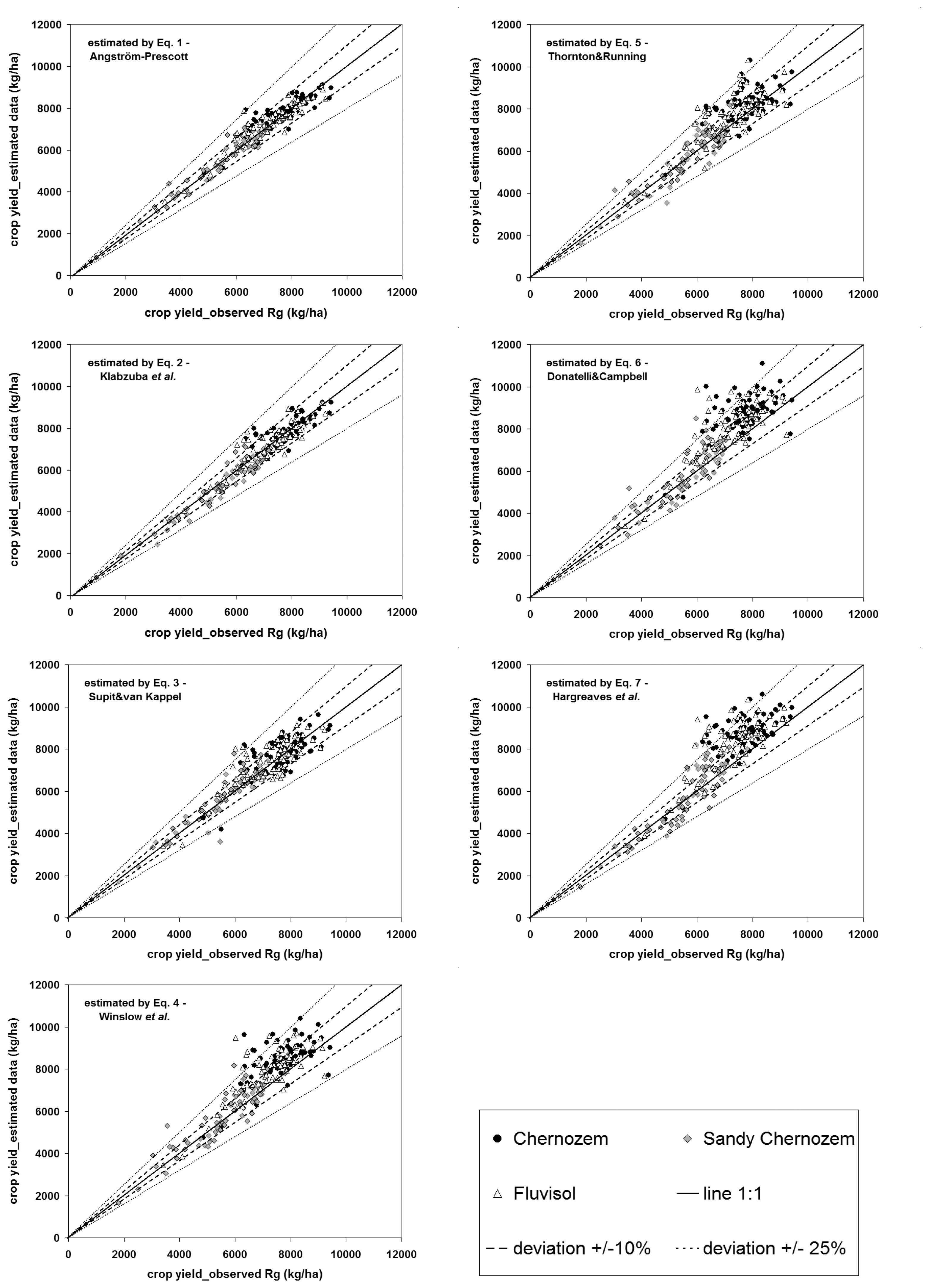
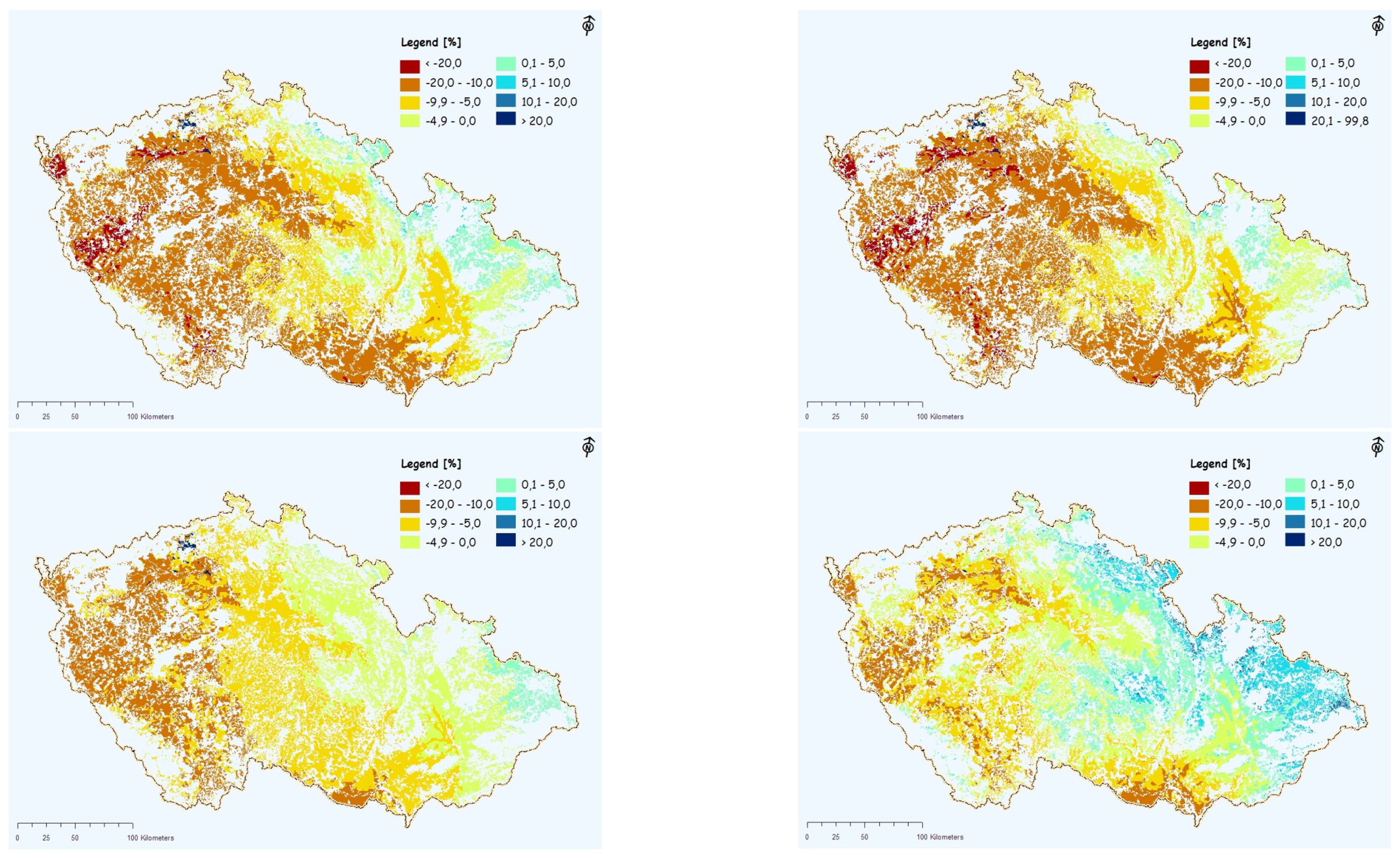
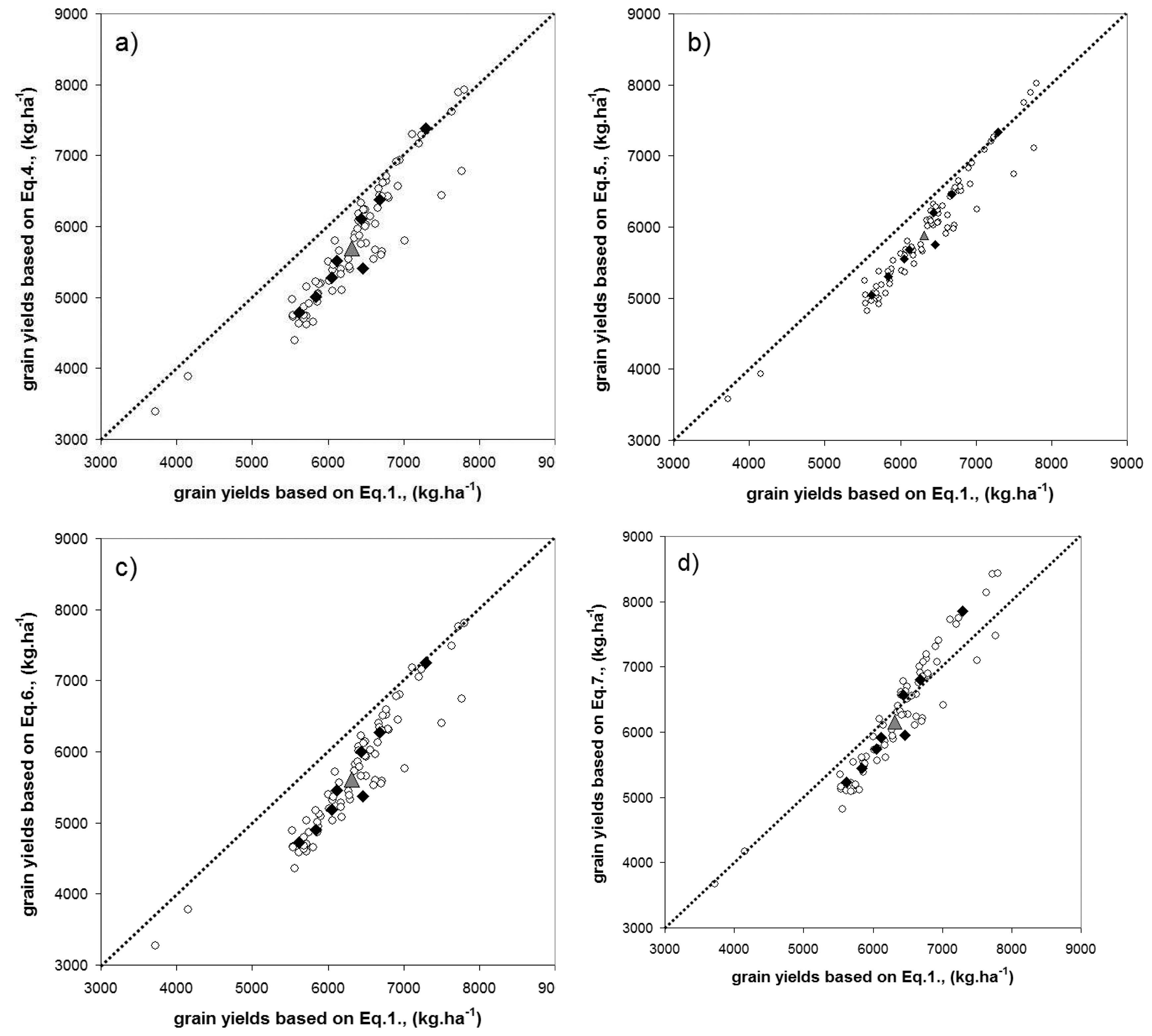
| Parameter | Eq. (1) | Eq. (2) | Eq. (3) | Eq. (4) | Eq. (5) | Eq. (6) | Eq. (7) |
|---|---|---|---|---|---|---|---|
| Ångström-Prescott | Klabzuba et al., | Supit and van Kappel, | Winslow et al. | Thornton and Running | Donatelli and Campbell | Hargreaves et al. | |
| [28,48] | [29] | [10] | [30] | [51] | [54] | [50] | |
| YEAR | |||||||
| a)R2 | 0.96 | 0.94 | 0.91 | 0.86 | 0.82 | 0.82 | 0.83 |
| b)Sl | 0.99 | 1.03 | 0.99 | 0.97 | 0.92 | 0.99 | 0.99 |
| c)MBE | 1.1 | 5.20 | 1.7 | 1.70 | 3.00 | 2.90 | 6.32 |
| d)RMSE | 14.50 | 20.39 | 24.71 | 28.60 | 29.74 | 32.03 | 32.05 |
| SPRING BARLEY GROWING SEASON (IV-VII) | |||||||
| R2 | 0.90 | 0.91 | 0.77 | 0.67 | 0.62 | 0.61 | 0.61 |
| Sl | 1.00 | 0.99 | 0.99 | 1.01 | 0.99 | 1.03 | 1.02 |
| MBE | 0.1 | 0.4 | 2.0 | 6.0 | 2.5 | 8.1 | 9.6 |
| RMSE | 11.4 | 12.6 | 17.2 | 23.1 | 23.5 | 26.5 | 26.5 |
| WINTER WHEAT GROWING SEASON (X-VII) | |||||||
| R2 | 0.97 | 0.94 | 0.91 | 0.87 | 0.85 | 0.85 | 0.84 |
| Sl | 0.99 | 1.02 | 0.99 | 1.01 | 0.99 | 1.02 | 1.01 |
| MBE | 1.3 | 3.4 | 1.4 | 3.6 | 6.3 | 4.0 | 8.1 |
| RMSE | 15.0 | 20.1 | 23.9 | 30.0 | 32.1 | 33.6 | 33.7 |
| Chernozem | |||||
|---|---|---|---|---|---|
| Depth (m) | BD (g cm-3) | OC (%) | θWP (m3 m-3) | θFC (m3 m-3) | θSAT (m3 m-3) |
| 0.3 | 1.33 | 2.70 | 0.21 | 0.35 | 0.43 |
| 0.6 | 1.52 | 0.40 | 0.16 | 0.32 | 0.40 |
| 0.9 | 1.49 | 0.20 | 0.11 | 0.36 | 0.42 |
| Sandy chernozem | |||||
| 0.3 | 1.56 | 1.30 | 0.08 | 0.28 | 0.37 |
| 0.6 | 1.52 | 0.40 | 0.05 | 0.19 | 0.39 |
| 0.9 | 1.49 | 0.20 | 0.05 | 0.19 | 0.39 |
| Fluvisol | |||||
| 0.3 | 1.37 | 2.88 | 0.20 | 0.35 | 0.42 |
| 0.6 | 1.35 | 2.58 | 0.18 | 0.34 | 0.42 |
| 0.9 | 1.38 | 2.46 | 0.18 | 0.35 | 0.40 |
| Soil | chernozem | sandy-chernozem | Fluvisol | |||
|---|---|---|---|---|---|---|
| s.barley | w.wheat | s.barley | w.wheat | s.barley | w.wheat | |
| Start of the simulation | 1st January | 10th October | 1st January | 10th October | 1st January | 10th October |
| Sowing date | 22nd March | 10th October | 22nd March | 10th October | 22nd March | 10th October |
| Sowing density (seeds.m-2) | 600 | 600 | 400 | 400 | 650 | 400 |
| Harvest date | 16th July | 9th July | 16th July | 9th July | 16th July | 9th July |
| Dose of N fertilizer (kg.ha-1) | 50 | 120 | 50 | 70 | 50 | 120 |
| Initial soil NO3 (kg.ha-1) | 25.6 | 25.6 | 2.1 | 2.1 | 29.8 | 29.8 |
| Initial soil NH4 (kg.ha-1) | 4.2 | 4.2 | 0.4 | 0.4 | 8.4 | 8.4 |
| Initial available soil water in the soil profile (mm) | 370 | 370 | 206 | 206 | 321 | 321 |
| Parameter | Eq. (1) | Eq. (2) | Eq. (3) | Eq. (4) | Eq. (5) | Eq. (6) | Eq. (7) |
|---|---|---|---|---|---|---|---|
| TRANSPIRATION | |||||||
| a)R2 | 0.93 | 0.91 | 0.84 | 0.80 | 0.78 | 0.77 | 0.74 |
| b)Sl | 1.00 | 0.99 | 1.03 | 1.08 | 1.03 | 1.10 | 1.10 |
| c)MBE | 0.6 | -1.4 | 3.2 | 7.7 | 2.93 | 9.8 | 9.5 |
| d)RMSE | 5.1 | 6.3 | 9.1 | 12.9 | 10.7 | 15.3 | 16.2 |
| e)RMSER | 0.4 | 1.4 | 3.1 | 7.9 | 2.8 | 10.0 | 9.8 |
| LAI_max | |||||||
| a)R2 | 0.95 | 0.94 | 0.90 | 0.87 | 0.83 | 0.85 | 0.81 |
| b)Sl | 1.00 | 0.98 | 1.01 | 1.07 | 1.02 | 1.09 | 1.08 |
| c)MBE | 0.3 | -1.99 | 1.7 | 7.0 | 2.4 | 8.9 | 8.2 |
| d)RMSE | 6.2 | 7.7 | 9.6 | 13.9 | 13.1 | 16.1 | 17.1 |
| e)RMSER | 0.1 | 2.0 | 1.4 | 7.3 | 2.1 | 9.3 | 8.4 |
| BIOMASS_MATURITY | |||||||
| a)R2 | 0.96 | 0.94 | 0.91 | 0.88 | 0.87 | 0.86 | 0.85 |
| b)Sl | 1.01 | 0.98 | 1.03 | 1.07 | 1.03 | 1.09 | 1.09 |
| c)MBE | 0.7 | -2.3 | 3.0 | 6.3 | 2.8 | 7.8 | 8.2 |
| d)RMSE | 4.9 | 6.2 | 8.2 | 11.8 | 9.9 | 13.9 | 15.4 |
| e)RMSER | 0.6 | 2.3 | 3.0 | 6.8 | 3.0 | 8.5 | 9.2 |
| YIELD | |||||||
| a)R2 | 0.95 | 0.93 | 0.88 | 0.86 | 0.86 | 0.83 | 0.81 |
| b)Sl | 1.01 | 0.98 | 1.04 | 1.07 | 1.04 | 1.09 | 1.10 |
| c)MBE | 1.2 | -2.2 | 4.2 | 6.7 | 3.6 | 8.4 | 9.2 |
| d)RMSE | 5.7 | 7.0 | 10.3 | 13.8 | 11.2 | 16.2 | 18.1 |
| e)RMSER | 1.1 | 2.3 | 4.3 | 7.3 | 3.8 | 9.2 | 10.3 |
| proportion of deviation > ± 10% | 6.0 | 12.8 | 24.1 | 37.9 | 24.1 | 43.3 | 48.2 |
| proportion of deviation > ± 25% | 1.4 | 1.1 | 1.8 | 7.1 | 5.3 | 12.4 | 16.3 |
| Parameter | Eq. (1) | Eq. (2) | Eq. (3) | Eq. (4) | Eq. (5) | Eq. (6) | Eq. (7) |
|---|---|---|---|---|---|---|---|
| TRANSPIRATION | |||||||
| a)R2 | 0.90 | 0.87 | 0.69 | 0.61 | 0.62 | 0.58 | 0.60 |
| b)Sl | 1.01 | 1.03 | 1.02 | 1.08 | 1.07 | 1.10 | 1.12 |
| c)MBE | 1.4 | 3.4 | 2.1 | 8.3 | 7.2 | 10.6 | 12.9 |
| d)RMSE | 4.5 | 6.1 | 8.2 | 12.3 | 11.7 | 14.3 | 15.9 |
| e)RMSER | 1.1 | 3.2 | 1.7 | 7.8 | 6.8 | 10.2 | 12.6 |
| LAI_max | |||||||
| a)R2 | 0.94 | 0.89 | 0.82 | 0.75 | 0.73 | 0.74 | 0.76 |
| b)Sl | 1.01 | 1.06 | 1.02 | 1.08 | 1.10 | 1.10 | 1.14 |
| c)MBE | 1.3 | 5.7 | 2.2 | 9.2 | 10.8 | 11.1 | 15.1 |
| d)RMSE | 5.6 | 9.7 | 10.0 | 14.7 | 16.7 | 16.1 | 19.2 |
| e)RMSER | 1.0 | 6.0 | 1.7 | 8.7 | 10.7 | 10.7 | 15.1 |
| BIOMASS_MATURITY | |||||||
| a)R2 | 0.94 | 0.92 | 0.84 | 0.80 | 0.81 | 0.79 | 0.81 |
| b)Sl | 1.01 | 1.01 | 1.02 | 1.07 | 1.05 | 1.09 | 1.11 |
| c)MBE | 1.1 | 1.1 | 1.9 | 7.3 | 5.4 | 9.2 | 10.8 |
| d)RMSE | 4.2 | 5.3 | 7.4 | 11.2 | 10.2 | 12.9 | 14.9 |
| e)RMSER | 0.9 | 1.2 | 1.6 | 7.3 | 5.5 | 9.3 | 11.2 |
| YIELD | |||||||
| a)R2 | 0.93 | 0.91 | 0.83 | 0.80 | 0.81 | 0.78 | 0.80 |
| b)Sl | 1.01 | 0.99 | 1.02 | 1.08 | 1.04 | 1.10 | 1.11 |
| c)MBE | 0.8 | -0.7 | 2.0 | 8.0 | 4.2 | 9.9 | 10.4 |
| d)RMSE | 4.7 | 5.5 | 7.8 | 11.8 | 9.4 | 13.8 | 14.5 |
| e) RMSER | 0.6 | 0.7 | 1.8 | 8.1 | 4.2 | 10.1 | 11.0 |
| proportion of deviation > ± 10% | 5.0 | 10.3 | 19.1 | 32.3 | 22.7 | 39.0 | 41.8 |
| proportion of deviation > ± 25% | 0.4 | 0.0 | 2.1 | 5.3 | 3.9 | 7.4 | 9.9 |
© 2007 by MDPI ( http://www.mdpi.org). Reproduction is permitted for noncommercial purposes.
Share and Cite
Trnka, M.; Eitzinger, J.; Kapler, P.; Dubrovský, M.; Semerádová, D.; Žalud, Z.; Formayer, H. Effect of Estimated Daily Global Solar Radiation Data on the Results of Crop Growth Models. Sensors 2007, 7, 2330-2362. https://doi.org/10.3390/s7102330
Trnka M, Eitzinger J, Kapler P, Dubrovský M, Semerádová D, Žalud Z, Formayer H. Effect of Estimated Daily Global Solar Radiation Data on the Results of Crop Growth Models. Sensors. 2007; 7(10):2330-2362. https://doi.org/10.3390/s7102330
Chicago/Turabian StyleTrnka, Miroslav, Josef Eitzinger, Pavel Kapler, Martin Dubrovský, Daniela Semerádová, Zdeněk Žalud, and Herbert Formayer. 2007. "Effect of Estimated Daily Global Solar Radiation Data on the Results of Crop Growth Models" Sensors 7, no. 10: 2330-2362. https://doi.org/10.3390/s7102330
APA StyleTrnka, M., Eitzinger, J., Kapler, P., Dubrovský, M., Semerádová, D., Žalud, Z., & Formayer, H. (2007). Effect of Estimated Daily Global Solar Radiation Data on the Results of Crop Growth Models. Sensors, 7(10), 2330-2362. https://doi.org/10.3390/s7102330


